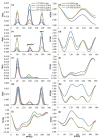Hydration Properties and Solvent Effects for All-Atom Solutes in Polarizable Coarse-Grained Water
- PMID: 26901452
- PMCID: PMC5816953
- DOI: 10.1021/acs.jpcb.6b00399
Hydration Properties and Solvent Effects for All-Atom Solutes in Polarizable Coarse-Grained Water
Abstract
Due to the importance of water in chemical and biological systems, a coarse-grained representation of the solvent can greatly simplify the description of the system while retaining key thermodynamic properties of the medium. A multiscale solvation model that couples all-atom solutes and polarizable Martini coarse-grained water (AAX/CGS) is developed to reproduce free energies of hydration of organic solutes. Using Monte Carlo/free energy perturbation (MC/FEP) calculations, results from multiscale and all-atom simulations are compared. Improved accuracy is obtained with the AAX/CGS approach for hydrophobic and sulfur- or halogen-containing solutes, but larger deviations are found for polar solute molecules where hydrogen bonding is featured. Furthermore, solvent effects on conformational and tautomeric equilibria of AA solutes were investigated using AA, CG, and GB/SA solvent models. It is found that the CG solvent model can reproduce well the medium effects from experiment and AA simulations; however, the GB/SA solvent model fails in some cases. A 7-30-fold reduction in computational cost is found for the present AAX/CGS multiscale simulations compared to the AA alternative.
Conflict of interest statement
The authors declare no competing financial interest.
Figures





Similar articles
-
Solvation free energies and partition coefficients with the coarse-grained and hybrid all-atom/coarse-grained MARTINI models.J Comput Aided Mol Des. 2017 Oct;31(10):867-876. doi: 10.1007/s10822-017-0059-9. Epub 2017 Sep 5. J Comput Aided Mol Des. 2017. PMID: 28875361 Free PMC article.
-
On Using Atomistic Solvent Layers in Hybrid All-Atom/Coarse-Grained Molecular Dynamics Simulations.J Chem Theory Comput. 2015 Sep 8;11(9):4460-72. doi: 10.1021/acs.jctc.5b00499. Epub 2015 Aug 12. J Chem Theory Comput. 2015. PMID: 26575936
-
Mixing MARTINI: electrostatic coupling in hybrid atomistic-coarse-grained biomolecular simulations.J Phys Chem B. 2013 Apr 4;117(13):3516-30. doi: 10.1021/jp311533p. Epub 2013 Mar 6. J Phys Chem B. 2013. PMID: 23406326
-
Adaptive resolution simulations of biomolecular systems.Eur Biophys J. 2017 Dec;46(8):821-835. doi: 10.1007/s00249-017-1248-0. Epub 2017 Sep 13. Eur Biophys J. 2017. PMID: 28905203 Review.
-
Advances in implicit models of water solvent to compute conformational free energy and molecular dynamics of proteins at constant pH.Adv Protein Chem Struct Biol. 2011;85:281-322. doi: 10.1016/B978-0-12-386485-7.00008-9. Adv Protein Chem Struct Biol. 2011. PMID: 21920327 Review.
Cited by
-
Adaptive Resolution Simulation of Supramolecular Water: The Concurrent Making, Breaking, and Remaking of Water Bundles.J Chem Theory Comput. 2016 Aug 9;12(8):4138-45. doi: 10.1021/acs.jctc.6b00536. Epub 2016 Jul 25. J Chem Theory Comput. 2016. PMID: 27409519 Free PMC article.
-
From quantum to subcellular scales: multi-scale simulation approaches and the SIRAH force field.Interface Focus. 2019 Jun 6;9(3):20180085. doi: 10.1098/rsfs.2018.0085. Epub 2019 Apr 19. Interface Focus. 2019. PMID: 31065347 Free PMC article. Review.
-
Solvation free energies and partition coefficients with the coarse-grained and hybrid all-atom/coarse-grained MARTINI models.J Comput Aided Mol Des. 2017 Oct;31(10):867-876. doi: 10.1007/s10822-017-0059-9. Epub 2017 Sep 5. J Comput Aided Mol Des. 2017. PMID: 28875361 Free PMC article.
-
Enhanced Monte Carlo Methods for Modeling Proteins Including Computation of Absolute Free Energies of Binding.J Chem Theory Comput. 2018 Jun 12;14(6):3279-3288. doi: 10.1021/acs.jctc.8b00031. Epub 2018 May 8. J Chem Theory Comput. 2018. PMID: 29708338 Free PMC article.
References
-
- Voth GA. Coarse-Graining of Condensed Phase and Biomolecular Systems. CRC Press; FL: 2009.
-
- Brini E, Algaer EA, Ganguly P, Li C, Rodriguez-Ropero F, van der Vegt NFA. Systematic Coarse-Graining Methods for Soft Matter Simulations - A Review. Soft Matter. 2013;9:2108–2119.
-
- Noid WG. Perspective: Coarse-grained Models for Biomolecular Systems. J Chem Phys. 2013;139:090901. - PubMed
-
- Marrink SJ, Tieleman DP. Perspective on the Martini Model. Chem Soc Rev. 2013;42:6801–6822. - PubMed
Publication types
MeSH terms
Substances
Grants and funding
LinkOut - more resources
Full Text Sources
Other Literature Sources
Molecular Biology Databases

